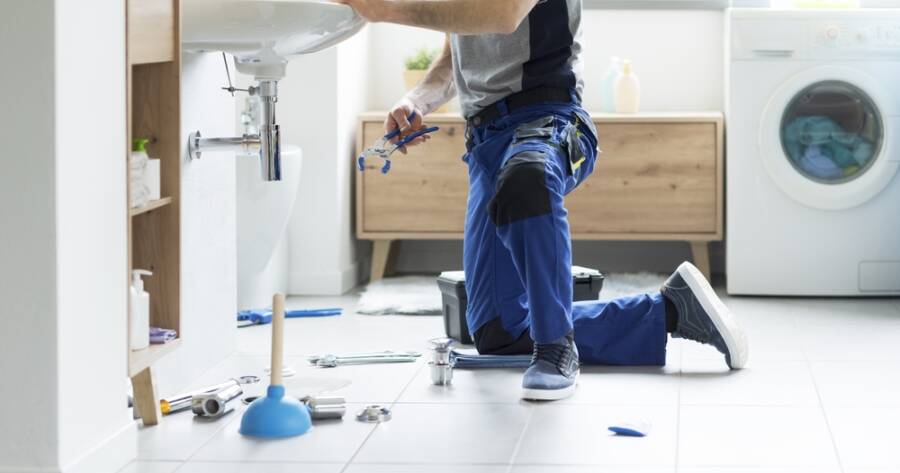Water suddenly gushing from a ceiling joint at midnight, a sewer stench creeping through floor drains, or a boiler that quits on a sub-zero morning all demand rapid response. Plumbing calamities threaten property, safety, and sanity, and delaying repairs often multiplies costs. Calling an emergency plumber at the right moment can turn a potential catastrophe into a manageable inconvenience.
Burst Pipes and Rapid Water Loss
A suddenly burst pipe can unleash gallons of water per minute, flooding floors, ruining drywall, and short-circuiting electrical systems. Common triggers include winter freezes, corrosion, and accidental nail punctures during renovations. Warning signs often start with hissing behind walls, damp spots on ceilings, or an abrupt drop in water pressure followed by the sound of running water when no tap is open.
Kill the main shut-off valve and call an emergency plumber without delay. Expect the technician to isolate the damaged section, crimp or cap the pipe to halt further leakage, and arrange a permanent repair once drying equipment is in place. They may also photograph damage for insurance claims and set up moisture meters to monitor hidden areas for mold risk.
Sewage Backups and Health Hazards
When wastewater reverses course and bubbles through floor drains or toilets, pathogens ride along. Sewage backups typically stem from tree-root intrusions, collapsed sewer lines, or heavy rainfall overwhelming municipal mains. You might notice slow gurgling drains, foul odors in bathrooms, or water pooling around basement floor drains just before the full backup arrives. Ignoring this warning can expose occupants to E. coli, hepatitis, and other dangerous microbes.
Emergency plumbers carry protective gear, high-capacity pumps, and hospital-grade sanitizers. They start by clearing blockages with sewer augers or hydro-jetting, disinfect contaminated surfaces, and recommend professional drying services. Expect them to camera-scope the main line to pinpoint structural damage and explain repair options such as trenchless lining or full replacement, giving you a clear roadmap toward a sanitary, odor-free home.
Total Loss of Hot Water
A sudden blast of cold from the shower often signals water-heater failure. Electric units may trip breakers, while gas heaters can lose pilot flames or suffer thermostat malfunctions. Discolored or metallic-tasting water, rumbling tank noises, or puddles beneath the appliance serve as early clues that internal components are corroding or sediment has built up inside. Left unchecked, overheating elements or pressure buildup can result in tank rupture.
An emergency plumber will first verify gas supply or power feed, then secure energy sources to prevent harm. They may flush sediment, replace thermostats, or swap faulty pressure-relief valves on the spot. If the tank is beyond repair, a same-day replacement can be arranged, bringing the system up to current efficiency codes and restoring hot water for showers and dish cycles quickly.
Persistent Clogs and Overflowing Fixtures
When plungers and drain cleaners fail, an obstruction deep within pipes may be responsible for sinks gurgling or toilets threatening to overflow. Hair, grease, or foreign objects can lodge in P-traps, but multiple slow drains at once usually point to a main-line blockage. Ignoring backflow risks water damage, foul odors, and bacterial contamination spreading throughout the house. During storms, tree roots can exacerbate the blockage by forcing soil into joints.
Emergency plumbers deploy motorized augers and high-pressure hydro-jetting to cut through roots and scour pipe walls clean. Cameras confirm the obstruction is fully cleared, preventing repeat clogs. Expect protective floor coverings, immediate waste removal, and advice on enzyme treatments that keep lines flowing. Technicians also outline preventive measures, such as installing root barriers or scheduling annual jetting, to avoid future overflows.
Frozen Pipes and Winter Emergencies
Sub-zero weather can freeze water inside exposed or poorly insulated pipes, creating ice plugs that expand and crack copper, PVC, or PEX. Telltale signs include frost on pipe surfaces, faucets that trickle or stop completely, and unusual banging noises as ice shifts. Acting before thawing occurs is critical because most ruptures happen when frozen sections start to warm. Undetected leaks can flood walls and basements within minutes.
Emergency plumbers arrive with pipe-thawing machines, heat cables, and thermal cameras to locate ice blockages without damaging walls. They thaw pipes evenly to prevent pressure spikes, patch splits, and may install insulation sleeves or reroute vulnerable lines. Homeowners receive guidance on maintaining safe indoor temperatures, sealing drafty crawlspaces, and draining outdoor spigots, turning a crisis into a lesson in cold-weather prevention.
Peace of Mind When Water Runs Wild
Plumbing emergencies rarely wait for convenient hours, yet swift professional help prevents scattered puddles from becoming structural nightmares. Recognizing early warning signs—burst pipes, sewage backups, cold showers, stubborn clogs, or frozen lines—empowers you to act before damage snowballs. Reputable emergency plumbers combine technical expertise with clear communication and transparent pricing, guiding you through stressful moments with confidence. When water, waste, or gas behaves unpredictably, calling a trusted expert is the surest way to protect both your home and your health.
